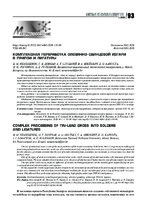| dc.contributor.author | Немененок, Б. М. | |
| dc.contributor.author | Довнар, Г. В. | |
| dc.contributor.author | Слуцкий, А. Г. | |
| dc.contributor.author | Шейнерт, В. А. | |
| dc.contributor.author | Капуста, Д. О. | |
| dc.contributor.author | Логонюк, И. И. | |
| dc.contributor.author | Руленков, А. Д. | |
| dc.coverage.spatial | Минск | ru |
| dc.date.accessioned | 2020-04-03T11:30:39Z | |
| dc.date.available | 2020-04-03T11:30:39Z | |
| dc.date.issued | 2020 | |
| dc.identifier.citation | Комплексная переработка оловянно-свинцовой изгари в припои и лигатуры = Complex processing of tin-lead dross into solders and ligatures / Б. М. Немененок [и др.] // Литье и металлургия. – 2020. – № 1. – С. 93-98. | ru |
| dc.identifier.uri | https://rep.bntu.by/handle/data/70361 | |
| dc.description.abstract | Использование отходов производства – одна из главных проблем современной экономики. В Беларуси отсутствует первичная металлургическая переработка природного сырья, поэтому использование вторичных материалов и отходов производства является для промышленности весьма актуальной и важной задачей, учитывая, что стоимость металлов, извлеченных из вторичного сырья в несколько раз меньше первичных. Одним из видов такого сырья является оловянно-свинцовая изгарь, которая состоит из оксидов олова и свинца с включениями корольков металлической составляющей. Наиболее ценным элементом в изгари служит олово, цена которого значительно превышает стоимость многих цветных металлов. Цель работы – исследование влияния различных технологических факторов на металлургический выход при переработке оловянно-свинцовой изгари в припои и лигатуры. Обобщены результаты ранее проведенных исследований, связанных с извлечением олова и свинца при переработке вторичного сырья. Представлены новые данные по технологическим способам более глубокой металлургической переработки изгари. Это позволило на их основе разработать варианты получения качественного припоя ПОС 61 и лигатур. | ru |
| dc.language.iso | ru | ru |
| dc.publisher | БНТУ | ru |
| dc.title | Комплексная переработка оловянно-свинцовой изгари в припои и лигатуры | ru |
| dc.title.alternative | Complex processing of tin-lead dross into solders and ligatures | ru |
| dc.type | Article | ru |
| dc.identifier.doi | 10.21122/1683-6065-2020-1-93-98 | |
| local.description.annotation | The use of industrial waste is one of the main problems of the modern economy. In Belarus, there is no primary metallurgical processing of natural raw materials, so the use of secondary materials and production waste is a very relevant and important task for the industry, given into account that the cost of metals extracted from secondary raw materials is several times less than the primary ones. One of the types of such raw materials is tin-lead dross (ash), which consists of tin and lead oxides with inclusions of the metal component beads. The most valuable element in dross is tin, the price of which is much higher than the cost of many non-ferrous metals. The aim of the work was to study the influence of various technological factors on the metallurgical output during the processing of tin-lead ash into solders and ligatures. In this regard the results of previous studies related to the extraction of tin and lead in the processing of secondary raw materials were summarized, and new data on technological methods for deeper metallurgical processing of dross (ash) were presented. This allowed them to develop options for obtaining high-quality solder type POS 61 and ligatures. | ru |

